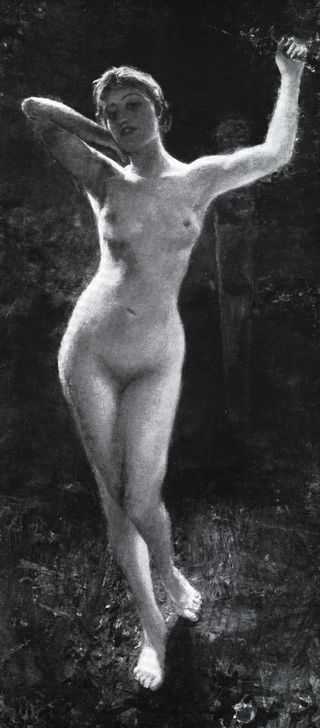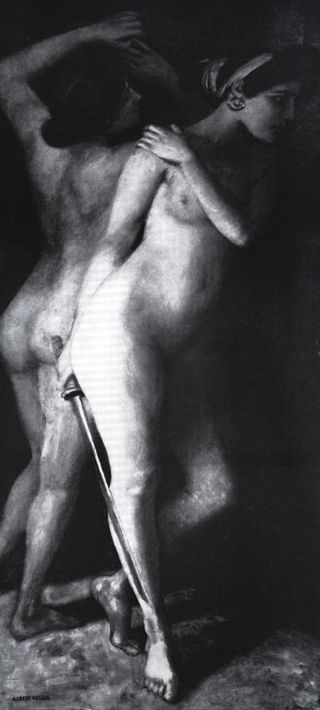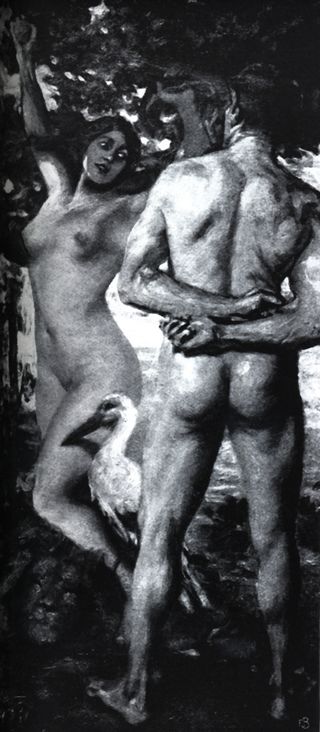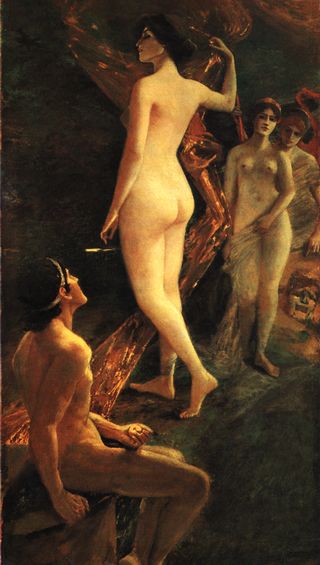Albert von Keller as Eroticist
Bacchus in a recent post made a kind reference to an earlier post of mine in which I included an image of a somewhat controversial painting by Albert von Keller entitled Im Mondschein. In retrospect it was a bit of an odd choice for me to have included that image in the sequence. It probably worked thematically, although it was a little odd historically. (Also, it was so beautifully painted while at the same time being more than a little transgressive, so really, how could I resist? I have scans of concept sketches and related material for Im Mondschein, so if there’s interest, it might get its own post later.)
But this got me to thinking. Although Albert von Keller was a fairly minor painter who barely rates even a paragraph on Wikipedia, he did produce some fairly remarkable images as an eroticist. Since I have the scans, it seems appropriate to pass them along, with perhaps some minor commentary.
Von Keller certainly had his moments of boldness, as can be seen from this small scan of his Akt am Strand (1874, model Cella Bertender):

Not too remarkable as a nude but note closely: a little tuft of the model’s pubic hair is displayed. For rather a long time the conventions of European painting dictated that the female nude didn’t have pubic hair. Or genitalia. Von Keller’s example of it isn’t the first — Gustave Courbet’s L’origine du monde precedes it by eight years, but it’s still an unusual work for its time.
Von Keller wasn’t usually this bold, especially early in his career. Like so many other artists, he could always find a good pretext for an erotic painting. Allegorical figures were one:

That painting is a study preliminary to a painting entitled Akademische Freiheit (Academic Freedom, 1888). I realize that all of us present and former academics must be saying to ourselves “If only academia had such freedom!”
Biblical themes were also a rich source of inspiration. Here is a study for a painting of Judith und Holophernes (dated 1895):

To my mind Judith has a rather scary expression, contemplating what she is about to do to Holophernes. But my favorite von Keller on biblical themes (which I have only in monochrome, I fear) is his Adam und Eva (1900):

Just what is Eve looking down at, with such an interested expression?
Von Keller certainly did well by classical themes as well. One good example, especially for its lovely use of light and color, is this Urteil des Paris (Judgment of Paris, 1891):

I must admit to a certain amount of puzzlement as to who’s clothed and why in this picture. Obviously it’s no accident that Aphrodite has turned up naked; clearly she knows where her strengths lie. Athena in back appears to be clothed. Is she, as a goddess connected with law and justice, waiting her turn in queue before disrobing? Or is it simply a measure of character: as a get-those-law-school-applications-in-the-mail type of deity, she is naturally more modestly dressed? Stranger still is why Paris is unclad. It makes perfect extrinsic sense, of course. What viewer doesn’t enjoy contemplating a beautiful nude young man? But it is a little harder to make sense of in terms of the internal logic of the picture. Did remote antiquity have an unusually balmy climate? Were proper laundry services in short supply at Troy? Is there some sort of we’ll-show-you-ours-if-you-show-us-yours game going on with the Olympians? I invite readers to speculate, at least as long as they don’t tell me something boring, like it was just artistic convention that Paris shouldn’t be wearing anything.
As his career went on, it appears that von Keller got bolder with both his theme and styles, painting some remarkable straight-up female nudes without apology. Consider this Kaskade (1910, model Gisela von Wehner):

And finally, in 1915, nearing the end of his life, another, much franker Eve:

The model for this last was Anni Söldner, identified by von Keller scholar Oskar Müller as “das letze Modell Albert von Kellers.”
A career perhaps worthy of more attention, indeed.
Shorter URL for sharing: http://www.erosblog.com/?p=3302








Actually, Paris nude would have been correct. The Judgment of Paris, according to myth, took place at an athletic competition. The Greeks did athletics in the nude.
Athena was ALWAYS shown clothed, Aphrodite almost always either nude (often with the wisp across the pudendum) or partially clothed, usually with at least a breast (more often than not the right, for some reason)exposed.
Most “classical” pictures and biblical pictures had a complex symbolic lexicon about dress, position in the picture, animals, etc. I suspect by the late nineteenth century, unless you were trained at one of the “academies”, it didn’t make a lot of sense to you.
I think Paris is so taken by Aphroditie’s glorious ass that he is about to make his choice of the three women…why else would his left hand be positioned where it is, his fingers cupped appropriately… I guess to get past the Censors, it was moved a few inches further down than it would naturally be…. But what is the image of what looks like a cross between the head of the Scarecrow and the Tinman to the right of Athena’s legs?